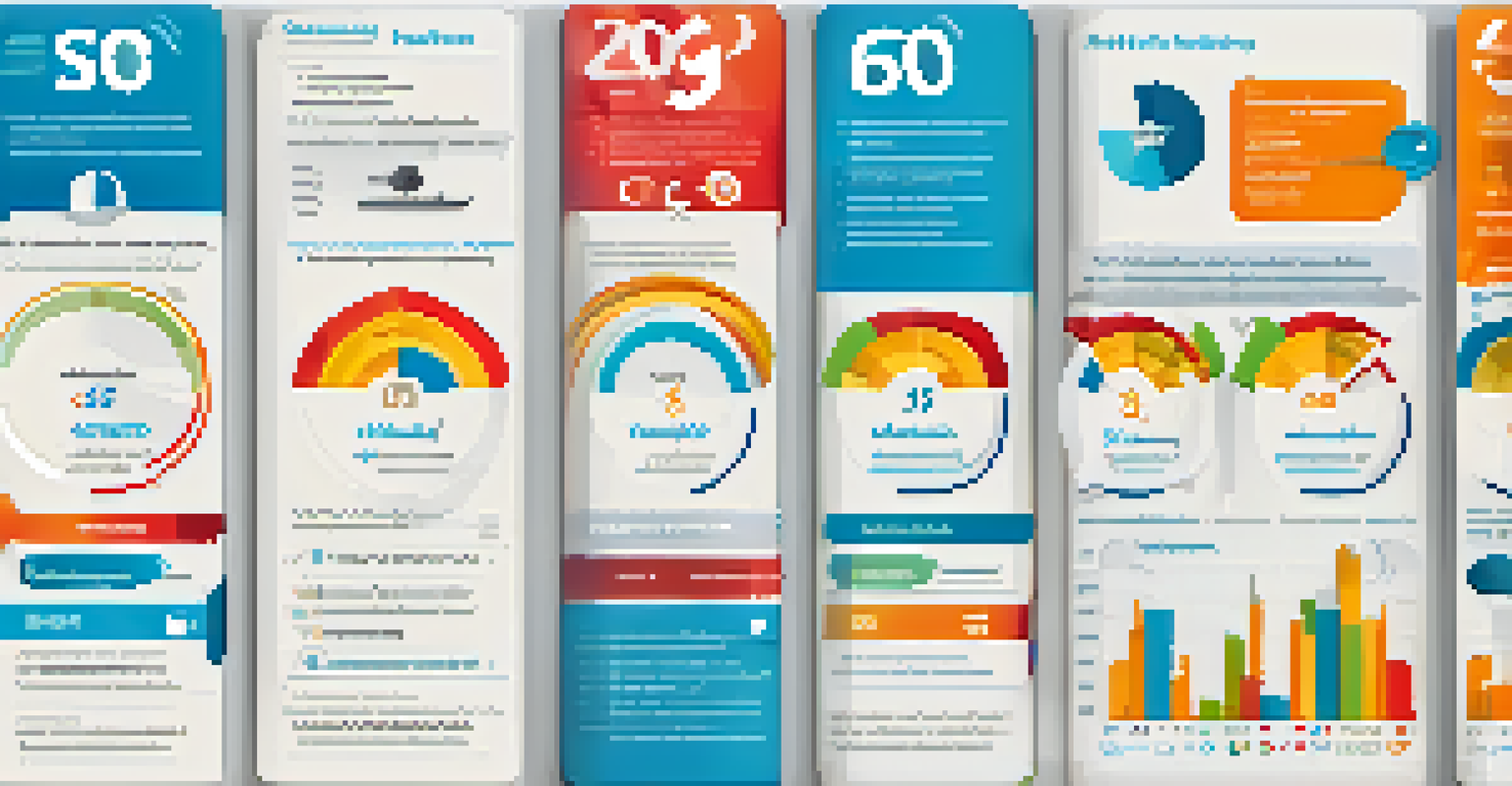Analyzing Competitors: Key Metrics to Monitor for Success

Understanding the Importance of Competitor Analysis
Competitor analysis is like a roadmap for your business; it helps you navigate the market landscape. By understanding your competitors, you can identify strengths and weaknesses that inform your strategy. This insight allows you to carve out your unique position, ensuring you stand out in a crowded marketplace.
To succeed in business, you need to be original, but you also need to understand what your competitors are doing.
Think of it as playing chess: knowing your opponent's moves can significantly influence your strategy. Competitor analysis isn't just about keeping tabs; it’s about leveraging that information to anticipate market trends and customer needs. This proactive approach can lead to better decision-making and ultimately, greater success.
In a dynamic business environment, staying ahead requires vigilance. Regularly analyzing your competitors helps you adapt and refine your offerings. It also fosters innovation, as you may discover gaps in the market that your competitors haven't addressed.
Website Traffic: A Key Indicator of Competitor Success
One of the first metrics to analyze is website traffic. This figure provides insights into how many visitors your competitors attract, which can reflect their market presence. Tools like SimilarWeb or SEMrush can help you gauge this data, giving you a clearer picture of their online reach.

High traffic often indicates effective marketing strategies, strong brand recognition, or valuable content. By examining their traffic sources, you can uncover what channels are driving success. This knowledge allows you to adjust your own marketing tactics, whether it’s focusing on social media, SEO, or email campaigns.
Competitor Analysis Drives Strategy
Understanding your competitors helps you identify market gaps and refine your business strategy.
However, traffic alone doesn’t tell the whole story. It’s essential to look at engagement metrics as well, such as bounce rates and average session duration. These figures help you understand not just how many visitors arrive, but how effectively competitors are keeping them engaged.
Social Media Engagement: Measuring Brand Connection
Social media engagement is another vital metric to monitor. High levels of likes, shares, and comments can indicate a strong connection with audiences. Tools like Hootsuite and BuzzSumo can help you track your competitors' social performance, shedding light on what resonates with their followers.
In business, you’re only as good as your competition.
Engagement rates often reflect the quality of content and the effectiveness of social media strategies. For example, if a competitor regularly shares interactive content like polls or quizzes, it might explain their high engagement. This insight can inspire you to experiment with similar tactics to enhance your own social media presence.
Moreover, observing the type of content that generates the most interaction can guide your content strategy. By identifying trends, you can tailor your posts to align with audience preferences, increasing your chances of building a loyal community around your brand.
SEO Performance: Ranking Insights for Competitive Edge
Search engine optimization (SEO) is crucial for online visibility. By analyzing your competitors' SEO performance, you can discover which keywords they rank for and how effectively they optimize their content. Tools like Ahrefs and Moz can provide valuable insights into their keyword strategies.
Understanding where your competitors excel in SEO can help you identify opportunities for your own optimization efforts. For instance, if a competitor ranks well for a particular long-tail keyword, you might consider creating similar content that targets that niche. This can enhance your visibility and attract more organic traffic.
Website Traffic Reflects Success
Analyzing competitors' website traffic can reveal effective marketing strategies and areas to improve your own reach.
Additionally, monitoring their backlink profiles can reveal potential partnership opportunities. If you see a competitor receiving links from reputable sites, it could indicate areas where you can build relationships to boost your own credibility and ranking.
Customer Reviews: Gauging Reputation and Satisfaction
Customer reviews are a goldmine of information when analyzing competitors. They reveal what customers love and dislike about their products or services. Platforms like Google Reviews and Trustpilot can provide insights into competitor reputation and customer satisfaction levels.
By understanding the strengths and weaknesses highlighted in reviews, you can refine your own offerings. For example, if customers frequently praise a competitor’s excellent customer service, it might inspire you to enhance your support systems. Conversely, if they receive complaints about a specific issue, you can capitalize on that gap.
Customer feedback also provides valuable insights into market trends and preferences. By staying attuned to what customers are saying, you can adapt your strategies and product offerings to better meet their needs, giving you a competitive edge.
Pricing Strategies: Understanding Market Positioning
Analyzing competitors' pricing strategies is crucial for positioning your own products effectively. Understanding how your prices compare can help you determine whether you should adjust your pricing or emphasize unique value propositions. Tools like Price2Spy can help you keep tabs on competitors’ pricing in real-time.
Pricing isn’t just about numbers; it reflects how you want to position your brand. For instance, if your competitors are offering lower prices, but you provide premium quality, your messaging should focus on that distinction. This helps justify your pricing strategy to potential customers.
Customer Reviews Inform Improvements
Customer feedback on competitors provides valuable insights for enhancing your own offerings and addressing market demands.
Additionally, consider how frequently your competitors adjust their prices. Regular promotions or discounts can indicate a strategy to boost sales or clear inventory. Monitoring these changes can help you time your own promotions more effectively, maximizing impact.
Content Strategy: Learning from Competitor Narratives
Content strategy plays a significant role in how competitors engage with their audience. By analyzing the types of content they produce—blogs, videos, infographics—you can understand what resonates with their audience. Tools like BuzzSumo can highlight the most shared content in your industry.
Observing the themes and topics your competitors cover can inspire your own content creation. If a competitor is gaining traction with educational content, it might be a signal to develop similar resources that provide value to your audience. This approach not only boosts engagement but positions your brand as an industry authority.

Furthermore, consider the frequency and consistency of their content updates. Regularly updated content tends to perform better in search rankings and keeps audiences engaged. By establishing a similar rhythm, you can enhance your online presence and attract more visitors.
Conclusion: Leveraging Competitor Analysis for Growth
In conclusion, monitoring your competitors is essential for long-term success. By analyzing key metrics such as traffic, engagement, SEO performance, and customer feedback, you can gather valuable insights to inform your strategy. This proactive approach not only helps you stay competitive but also fosters innovation within your business.
Remember, competitor analysis is not about copying; it's about learning and adapting. Use the insights gained to refine your offerings and marketing strategies, ensuring that you meet your audience's needs effectively. The ultimate goal is to carve out your unique position in the market.
As you implement these insights, keep in mind that the market is always evolving. Regularly revisiting your competitor analysis will help you stay ahead of the curve and continuously improve your business strategy.